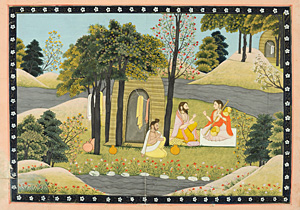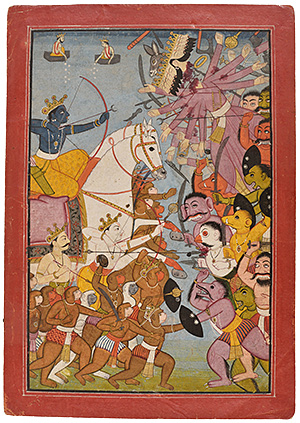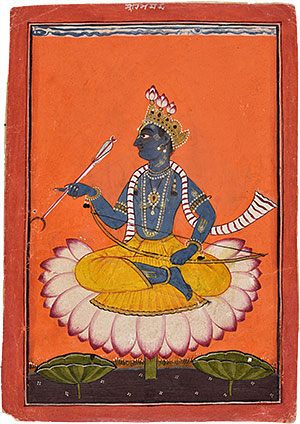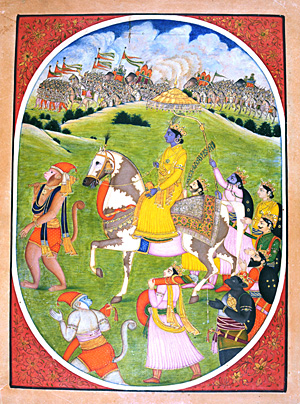The story of Rama
Indian miniatures from the National Museum, New Delhi
Dates + venue
22 May – 23 August 2015
Orde Poynton Gallery
A tale of love, loyalty, betrayal and the victory of good over evil, the Ramayana is one of the world’s great epics. It is ubiquitous in Indian life and culture as popular entertainment and moral guidance. The best known form of the story is attributed to a transcription by Valmiki, a poet of the fourth century BCE, but the Ramayana has as many variants as it does narrators. In the extraordinary exhibition The story of Rama: Indian miniatures from the National Museum, New Delhi, the Ramayana is told through one hundred and one paintings, each illustrating a key moment from the narrative. It begins with a painting of the sage Narada asking Valmiki to write the story.
 Kangra style, Pahari
Sage Narada requests Valmiki to write the story of Rama early 19th century, opaque watercolour and gold on paper National Museum, New Delhi, India
Kangra style, Pahari
Sage Narada requests Valmiki to write the story of Rama early 19th century, opaque watercolour and gold on paper National Museum, New Delhi, IndiaThe Ramayana takes its name from the hero Rama, an exemplary prince and ideal man, admired for his honour, valour and compassion. Rama is an avatar of the great Hindu god Vishnu, preserver of peace, who takes an earthly form when he is needed to restore balance to the world. Among Vishnu’s other avatars are Kurma the turtle, boar-headed Varaha and the much-adored Krishna, all of whom are depicted with distinctive blue skin of varying intensities.
In legend, Vishnu was resting atop Shesha, king of the serpent gods, in his heavenly abode when woken by 3333 gods calling him to Earth to vanquish Ravana, the destructive demon king of Lanka. At the same time, King Dasaratha of Ayodhya was engaged in sacrifice in the hope of being granted a son. He was astounded when Vishnu, in the form of a beautiful young man holding a bow and arrow, emerged from a burst of flames and announced himself as Rama, eldest son of Dasaratha. Rama’s three younger brothers were born of two of Dasaratha’s three wives: Bharata was the son of Kaikeyi and Lakshmana and Shatrughna were Sumitra’s twin boys.
Good, handsome and extremely strong, Rama won the hand of the virtuous Sita, an incarnation of Vishnu’s consort Lakshmi, goddess of beauty and prosperity, in a contest of strength and skill. Rama easily lifted and shot an arrow from the bow of the god Shiva, accurately hitting a tiny, moving target. The weapon had proved impossible for the other suitors to even budge. Among them was the demon king Ravana, who swore revenge after learning of Sita’s amusement at his failed attempt; in another version of the story, Ravana’s wrath is instead incurred when Rama rejects the advances of the demon king’s sister.
 Kangra style, Pahari, Ravana proposes to Sita in the Ashoka vatic. Sita refuses and warns him of the serious consequences with her finger, early 19th century opaque watercolour and gold on paper National Museum, New Delhi, India
Kangra style, Pahari, Ravana proposes to Sita in the Ashoka vatic. Sita refuses and warns him of the serious consequences with her finger, early 19th century opaque watercolour and gold on paper National Museum, New Delhi, IndiaAfraid that Rama would become king ahead of her son Bharata, Kaikeyi manipulated King Dasaratha into exiling Rama for fourteen years and making Bharata heir to the throne. Rama dutifully complied and, with Sita and Lakshmana, went to live in a forest. Dasaratha died heartbroken and Bharata, loyal to Rama, reluctantly ruled as regent. While in exile, Sita was enchanted by a golden deer and asked Rama to catch it for her as a companion. As the elusive deer (Ravana’s evil uncle Maricha in disguise) led Rama further and further away, Sita was abducted by Ravana. The deer chase is represented in a fine and sparse early seventeenth-century painting depicting the beautiful animal leaping away from blue-skinned Rama who, with one foot in the air, stands ready with his bow and arrow.
With the help of the monkey general Hanuman and his army, Rama and Lakshmana searched for Sita. The many adventures and obstacles along the way are dramatically played out through the miniatures. An image from the modern state of Himachal Pradesh in the foothills of the Himalayas is one of three paintings in the exhibition representing the mighty final battle between Rama and Ravana.
 Guler style, Pahari The great battle between Rama
and Ravana c 1780, opaque watercolour on paper National Museum, New Delhi, India
Guler style, Pahari The great battle between Rama
and Ravana c 1780, opaque watercolour on paper National Museum, New Delhi, IndiaThe clash, involving the monkey army and the demon forces with bulging eyes and fangs fighting alongside the primary hero and villain, is illustrated in lively and gruesome detail. While multi-headed Ravana is graphically decapitated, his heads regrowing each time, heavenly beings in floating boats scatter blossoms on Rama, who kneels astride the white horses of Indra, king of the gods. The style of the painting is described as Guler after the previous name of the state in which it was created. Guler is one of several painting schools, including Kangra, Basohli and Mandi, which are also categorised under the wider term Pahari (from pahar, meaning ‘hill’ or ‘mountain’).
 Chamba style, Pahari, The abduction of Sita by Ravana from Panchvati; the bird Jatayu tries to save Sita, late 18th century, opaque watercolour on paper National Museum, New Delhi, India
Chamba style, Pahari, The abduction of Sita by Ravana from Panchvati; the bird Jatayu tries to save Sita, late 18th century, opaque watercolour on paper National Museum, New Delhi, India Another Pahari painting depicts Sita, once rescued, undergoing a trial by fire to prove she has been faithful to Rama. In a lush green landscape, Sita emerges from the flames unscathed and is shown on the left side of the painting seated beside Rama and receiving the gods, including Shiva, wearing a tiger-skin cloth, four-headed Brahma and Agni, the god of fire, as well as the monkey allies. After all the drama, tension and violence associated with Sita’s rescue, Rama, Lakshmana, Sita, Hanuman, the monkey king Sugriva and attendants return victorious to Ayodhya in a flying chariot rich with floral ornamentation. The chariot, one of the spoils of Rama’s victory, had been stolen by Ravana from his own brother to whom it was a gift from Brahma. The return of the heroes to Ayodhya was marked with great joy, the city resplendent with the light of oil lamps. Their homecoming is the origin of Divali, the festival of lights held each autumn to celebrate the triumph of goodness, knowledge and light over evil, ignorance and darkness.
 Basohli style, Pahari The portrait of Rama c 1730, opaque watercolour and gold on paper National Museum, New Delhi, India
Basohli style, Pahari The portrait of Rama c 1730, opaque watercolour and gold on paper National Museum, New Delhi, India Created between the seventeenth and nineteenth centuries from across India, the paintings not only present the fantastic story of the Ramayana but also the diversity of regional painting styles that developed over time. Most of the paintings were originally created as illustrations to written manuscripts that have long since dispersed. A key image is a painting of Rama seated cross-legged on a large lotus blossom and holding the bow and arrow that are his identifying attributes. For all the extraordinary detail and complexity of so many of the paintings in the exhibition, this Basohli-style portrait shows Rama in profile against an unadorned background of pure, rich orange.
 Mandi style, Pahari
The coronation procession c 1800, opaque watercolour on paper, National Museum, New Delhi, India
Mandi style, Pahari
The coronation procession c 1800, opaque watercolour on paper, National Museum, New Delhi, IndiaIt is a great pleasure to be able to display these one hundred and one paintings from the National Museum, New Delhi, and to share the excitement of the Ramayana with visitors to the National Gallery of Australia in Canberra. The exhibition marks an important collaboration between these two premier national institutions.

